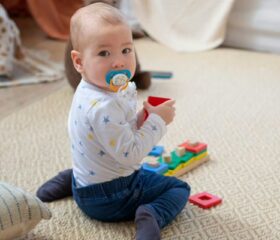When Is It Safe for Your Baby to Go on Swings?
Swings are a playground staple and a timeless source of fun, but is your little one ready for them?

There isn’t one universal age when babies are guaranteed to be ready to start playing on the swings. Rather, your baby has to meet certain developmental milestones before she can join in the fun.
Read on to find out how to tell if your baby is physically ready for swings, how to introduce them safely, what the benefits of going on swings are, and what to do if she doesn’t like them as much as you’d hoped.
When will your baby be ready for swings?
Your child may not be ready for traditional belt or “big-kid” swings until she’s around 3 years old. 1
Belt swings are the ones that consist of just a single plank or a strip of rubber or plastic, which means using them requires the ability to balance, which most children don’t develop until they’re toddlers (at least).
When will your baby be ready for bucket swings?
Babies can go on “bucket swings” once they can sit and hold their heads up without support, which is a milestone that often comes around 9 months of age. 2
Bucket swings are partially enclosed, with two leg holes and front and back support. This makes them much safer since it’s very hard for a child to fall out of them (when seated correctly).
At around the 9-month mark, your baby should have the required head and neck control and core strength to sit safely in one of these swings.
Note that beyond her ability to sit up on her own, she should also meet the swing manufacturer’s height and weight recommendations. If you’re at a park, check if it has a sign with those details. If not, at the very least, check that your baby fits in the seat. She should always be supervised by you or another adult.
How to introduce bucket swings to your baby
Even if your baby has reached all the developmental milestones to go on bucket swings, her first few swings should be very gentle. Remember that this is a new experience for her, and she might need time to get used to the sensation.
Once you settle your baby in the swing, push it slowly and observe her reaction closely. If she’s giggling, smiling, or looks otherwise relaxed, you can push the swing a little harder to up the fun.
However, if she cries or fusses, take her out and try another day. Don’t force her to swing if she’s not enjoying it.
Safety tips for letting your baby use bucket swings
Follow these safety tips to ensure your little one won’t get hurt when she’s on the swings:
- Always use safety features: Make sure your baby is securely seated. She shouldn’t be standing or kneeling. Always use the harnesses and straps to add an extra layer of protection and prevent your baby from sliding around or falling out.
- Check the area’s safety: Look for swings that are above energy-absorbing surfaces, such as wood chips, rubber mats, or sand. That’s as opposed to hard surfaces like asphalt, concrete, or hard-packed soil, which offer little protection in case of a fall. 3 Be aware of other children playing nearby. Check that no one is running in front of or behind the swing to prevent accidental collisions.
- Avoid swinging on hot days: When it’s hot out, you might want to give swinging a miss, or at least test the swing seat and chains with your hand before placing your baby in them. Plastic and metal chains can become very hot and can even cause burns. 3
- Limit swinging sessions: Swinging for too long can cause overstimulation in babies, which can lead to tiredness, crying, tantrums, or refusal to cooperate. 4 Start with 15-minute sessions, then lengthen or cut back according to how your baby responds. Remove your baby from the swing if she seems drowsy; falling asleep on a swing is dangerous, as your baby’s head might fall forward and compress her airway.
- Constantly supervise your baby: As mentioned earlier, there should be a responsible adult supervising your baby at all times. When you’re on baby-watching duty, stay within arm’s reach and avoid distractions, such as your phone.
Teach your child how to use swings safely when she grows older
When your child graduates from bucket swings to “big-kid” swings, remember to teach her playground etiquette, such as not standing or kneeling on a swing, staying away from moving swings, and stopping completely before getting off. This will keep her safe (along with other kids, too).
What benefits does going on swings have for babies?
Introducing your baby to swings isn’t just fun, it also aids her development. Specifically, it benefits her:
Sensory motor development
Sitting on a swing helps your baby develop control over her head, neck, and torso muscles, which are essential for balance and coordination as she grows. Her hand muscles will also strengthen when she holds onto the ropes or the seat while swinging. 5
Looking at the world while she’s on a moving swing lets your baby adapt to different sensations and stimulates her vestibular system, which is responsible for balance and spatial awareness. 56
Her attention span and focus may also improve as she tracks objects and people while on the swing.
Mood and bonding
As you may remember from your own childhood, going on swings is often an instant mood booster. It’s especially relaxing for many babies. If your little one is in a bad mood, a few minutes of slow rocking on the swings might help calm her down. 5
As a cherry on top, swinging is a great opportunity for you to bond with your baby outdoors. Getting in some sunshine and fresh air while having a blast is always a good idea.
What if your baby doesn't like swings?
As fun as swings are, like almost every activity, this isn’t for every child.
Don’t be discouraged if your little one isn’t an instant fan of swings. You can try different rocking speeds to see what your baby prefers.
Try engaging with her while she’s on the swing. Talking to her, singing songs, or pointing out interesting things around her can make the experience more enjoyable.
To reiterate, don’t force your baby to play on the swing if she clearly dislikes it. You can try another day. In the meantime, try other activities that stimulate her growth and development in similar ways.
What to consider if you want to buy a home swing
Avoid swing seats that are made out of hard materials, such as metal or wood. 3 Your swing set (and any other home playground equipment you buy) should have a label that specifies it meets the safety standard ASTM F1148. 3
Be sure to follow the instructions carefully when assembling the swing to avoid serious risks, such as strangulation, entanglement, or falling. Install the swing at least 6 feet from fences or walls. 3 Check regularly for loose nuts and bolts or any rusty, broken parts that might cause accidents.
If you’re at all unsure how to assemble the swing, it’s a good idea to seek help from a professional to make absolutely sure it’s as safe as it can be.
Final thoughts
Introducing your little one to swings opens a whole new world of fun. Just make sure she’s developmentally ready for the kind of swing you choose.
Now, go out and create some lasting memories with your child. Have fun on the swings!
Article Sources
- University of Pittsburgh Office of Child Development. "Developmental Milestones Foster Parent Guide" Retrieved November 13, 2025.
- Safe Kids Worldwide. "Playground Safety for Babies" Retrieved November 13, 2025.
- American Academy of Pediatrics. "Safety Tips For Home Playground Equipment" Retrieved November 13, 2025.
- Raising Children Network (Australia). "Overstimulation: babies and children" Retrieved November 13, 2025.
- The Motor Story. "Swinging for Babies and Toddlers" Retrieved November 13, 2025.
- Cleveland Clinic. "Vestibular System" Retrieved November 13, 2025.







